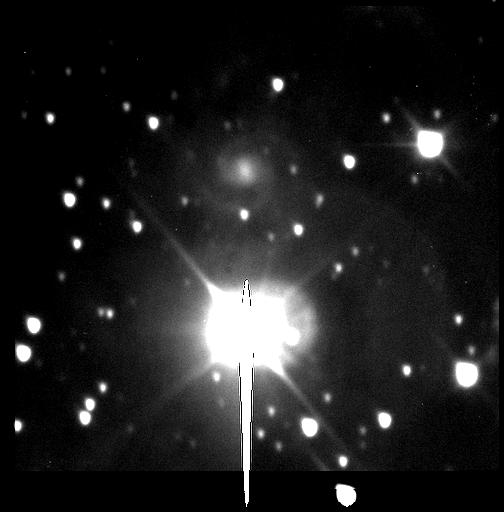

The following is a list of the data and the processing performed on it:
File |
Date |
Time (CST) |
Exposure (s) |
Filter |
CCD Temp (C) |
Processing Steps |
| Bias | ||||||
| b1-50-0-015 | 9/14/2004 | 10:02:05 | 0 | ~ | -50 | 1) Images imported as a stack |
| b2-50-0-016 | 9/14/2004 | 10:03:44 | 0 | ~ | -50 | |
| b3-50-0-017 | 9/14/2004 | 10:04:12 | 0 | ~ | -50 | |
| b4-50-0-018 | 9/14/2004 | 10:04:35 | 0 | ~ | -50 | |
| b5-50-0-019 | 9/14/2004 | 10:05:07 | 0 | ~ | -50 | |
| b6-50-0-020 | 9/14/2004 | 10:05:32 | 0 | ~ | -50 | |
| b7-50-0-021 | 9/14/2004 | 10:05:54 | 0 | ~ | -50 | |
| b8-50-0-022 | 9/14/2004 | 10:06:20 | 0 | ~ | -50 | |
| b9-50-0-023 | 9/14/2004 | 10:06:45 | 0 | ~ | -50 | |
| b10-50-0-024 | 9/14/2004 | 10:07:07 | 0 | ~ | -50 | |
| b11-50-0-025 | 9/14/2004 | 10:07:32 | 0 | ~ | -50 | |
| b12-50-0-026 | 9/14/2004 | 10:09:35 | 0 | ~ | -50 | |
| b13-50-0-027 | 9/14/2004 | 10:10:03 | 0 | ~ | -50 | |
| b14-50-0-028 | 9/14/2004 | 10:10:33 | 0 | ~ | -50 | |
| b15-50-0-029 | 9/14/2004 | 10:10:57 | 0 | ~ | -50 | |
| Darks | ||||||
| d1-50-300-001 | 9/14/2004 | 8:12:22 | 300 | ~ | -50 | Steps 1-3 from Bias frames repeated |
| d2-50-300-002 | 9/14/2004 | 8:20:35 | 300 | ~ | -50 | |
| d3-50-300-003 | 9/14/2004 | 8:26:13 | 300 | ~ | -50 | |
| d4-50-300-004 | 9/14/2004 | 8:32:41 | 300 | ~ | -50 | |
| d5-50-300-005 | 9/14/2004 | 8:38:09 | 300 | ~ | -50 | |
| Flats | ||||||
| sc1-50-300-001 | 9/14/2004 | 10:12:02 | 300 | clear | -50 | Steps 1-3 from Bias repeated |
| sc1-50-300-002 | 9/14/2004 | 10:20:19 | 300 | clear | -50 | |
| sc1-50-300-003 | 9/14/2004 | 10:26:31 | 300 | clear | -50 | |
| sc1-50-300-004 | 9/14/2004 | 10:32:08 | 300 | clear | -50 | |
| sc1-50-300-005 | 9/14/2004 | 10:37:54 | 300 | clear | -50 | |
| sc1-50-300-006 | 9/14/2004 | 10:43:35 | 300 | clear | -50 | |
| Target | ||||||
| ic239c1-50-300-006 | 9/14/2004 | 8:43:51 | 300 | clear | -50 | Steps 1-5 from Flats repeated |
| ic239c2-50-300-007 | 9/14/2004 | 8:54:26 | 300 | clear | -50 | |
| ic239c3-50-300-008 | 9/14/2004 | 9:03:16 | 300 | clear | -50 | |
| ic239c4-50-300-009 | 9/14/2004 | 9:16:59 | 300 | clear | -50 | |
| ic239c5-50-300-010 | 9/14/2004 | 9:22:46 | 300 | clear | -50 | |
| ic239c6-50-300-011 | 9/14/2004 | 9:30:38 | 300 | clear | -50 | |
| ic239c7-50-300-012 | 9/14/2004 | 9:36:05 | 300 | clear | -50 | |
| ic239c8-50-300-013 | 9/14/2004 | 9:43:09 | 300 | clear | -50 | |
| ic239c9-50-300-014 | 9/14/2004 | 9:50:33 | 300 | clear | -50 | |
| ic239c10-50-300-015 | 9/14/2004 | 9:56:04 | 300 | clear | -50 | |
________________________________________
The following are the master calibration frames, created as described previously. The numbers below the links represent min/max values of the linear transformation function applied to each to show each image to its best:
| MASTER BIAS | MASTER DARK | |
| -38.4/28.59 | 16.85/243.79 | 0.91/1.08 |
And these are the changes, from raw images to final average, images except for final average displayed North down and east left, due to ImageJ's penchant for flipping FITS files:
|
AVERAGE IMAGE |
| Raw Images |  |
| Overscan Subtracted and Cropped | |
| Dark Subtracted | |
| Bias Subtracted | |
| Flat Divided | |
North up, East left |
________________________________________
The calibration frames did do an adequate job at getting rid of the noise due to the CCD and the optics, but processing would have been more effective if there had been a way of correcting for the light interference from the stars in the image; the really bright star south of the galaxy in particular. One problem was that once the master flat frame was divided out, each image seemed to develop black spots, two of which were around (174, 396) and (254, 280). However, since these were on fixed pixel locations on each image, and there was slight offset from image to image, averaging the image took care of them.
If we were to attempt to collect this data, I think we could improve the overall quality of the image by attempting to keep the galaxy more or less centred in the image, like in frames -009 and -010, which would minimize the effect of the bright star somewhat. There wouldn't be as much overflow anyway.